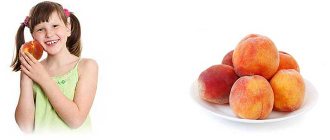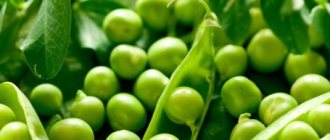Properties of radish
Nutritional value and composition | Vitamins | Minerals
How much does radish cost (average price for 1 kg)?
Moscow and Moscow region.
23 rub.
Radish has been known to people since ancient times. This is one of the most ancient cultivated plants on Earth. The homeland of radish is considered to be Egypt and China. The familiar radish from Egypt “moved” first to Greece, then spread throughout Europe and only then came to Russia. In Rus', radish has long been famous for its ability to relieve a wide variety of ailments.
What are the benefits of radish for weight loss?
What are the benefits of radish for those who want to lose weight? Here's what:
The presence of a large amount of fiber helps cleanse the intestines of waste and toxins, which makes the skin fresher, the stomach flatter, and the indicator on the scale reduced.
The lack of fat and minimal calorie content will certainly not lead to weight gain, so eat radish often (but taking into account contraindications).
Radish minerals support normal water-salt metabolism, as a result of which swelling quickly goes away, weight decreases, as does body volume.
Radish prevents fat, cholesterol, and salt deposits from accumulating, which also makes the appearance more attractive.
Benefits of radish
Traditional medicine has always appreciated the beneficial properties of radish. The secret of this lies in its composition. The elements necessary for health were found in radish: calcium, sodium, potassium, sulfur, as well as iodine, phosphorus, and iron. Radish contains a lot of organic acids and vitamins C, B and others.
The benefits of radish have been proven in the treatment and prevention of many diseases. Radish juice is especially effective in this regard. It is recommended to use it to improve the functioning of the gastrointestinal tract. It is able to prevent the development of atherosclerosis. Radish is also useful for combating the formation of stones in the kidneys and gall bladder. Grated radish is successfully used to treat radiculitis.
Radish improves appetite and removes toxins from the body. It has been proven that radish is especially effective in combination with other vegetables; in this case, the benefit of radish increases many times over. Radish is recommended for use by patients with diabetes, as radish has the ability to lower blood sugar levels.
Radish has truly wonderful properties when combined with honey. This drug has long been used to get rid of colds. Surely almost every person has used this remedy. Colds in children are often treated this way. Radish juice helps with cough. If honey is not available, granulated sugar can be used. The effect will be the same. Grated radish is used for inhalation. This is truly a universal medicine.
Cosmetology has also paid attention to radishes. Radish juice helps fight unwanted freckles and skin pigmentation. Radish masks return the skin to a healthy and vibrant appearance. Radish also turned out to be indispensable for hair. Rubbing radish pulp into the hair roots helps strengthen them.
The calorie content of radish is 36 kcal. per 100 gr. Therefore, radish will also be extremely useful in dietary nutrition. It is added to various vitamin salads, to which radish gives a unique taste and special piquancy.
On the shelves of our stores you can find the following varieties of radish:
- Black radish
- Green radish
- White radish
- Red radish
- Margelan (Chinese) radish
What chemical elements are included, how many calories are in a vegetable?
Calorie content and BZHU per 100 grams
- Fresh. The calorie content of fresh radish is 32 kcal per 100 grams of product. Amount of proteins – 2 g, fats – 0.2 g, carbohydrates – 6.5 g.
- Pickled. The calorie content of pickled radish is 57 kcal per 100 grams of product. Amount of proteins – 0.9 g, fats – 0.35 g, carbohydrates – 15.5 g.
- In the salad. The calorie content of radish in salad may vary depending on the recipe for its preparation, but the average value is 40 kcal per 100 grams of product. Amount of proteins – 1.8 g, fats – 2 g, carbohydrates – 5 g.
Vitamins
| Vitamin name | Content, mg | Role in the body |
| Retinol (A) | 3-4 |
|
| Thiamine (B1) | 0,03 |
|
| Pyridoxine (B6) | 0,06 |
|
| Tocopherol (E) | 0,1 |
|
| Ascorbic acid (C) | 29 |
|
Glycemic index
GI (glycemic index) is an indicator characterizing food products. It allows you to evaluate the rate at which carbohydrates are absorbed from them and how they affect the glucose concentration.
The higher the GI of a certain product, the faster the sugar level in the body will rise after eating it. Radish is recommended for consumption by people who suffer from diabetes, as it has a low glycemic index (about 15).
Macronutrients
Content of macroelements per 100 g of product:
- calcium – 35 mg;
- phosphorus – 26 mg;
- potassium – 350 mg;
- sodium – 13 mg;
- magnesium – 21 mg.
Application
The maximum amount of nutrients is retained in raw radish. You don't have to cut off the outer layer of a young vegetable. It is not advisable to eat radish at night. Green radish is not recommended for gastritis with high acidity, stomach ulcers and some other acute diseases, so you should consult your doctor before taking it.
Market Analytics
- COVID-19 is changing the rules of the game in the cosmetics market
- Beauty of the future: cosmetic innovations 2020
- New ingredients are the driving force of the cosmetics industry
Convenient search for beauty salons on our website
Beauty salons in Moscow Beauty salons in St. Petersburg Beauty salons in Ekaterinburg Beauty salons in Novosibirsk
Latest blog posts on our website
- Naturecream / Geranium (Pelargonium) oil for skin health and beauty
- Prostye-sovety / Save on a beauty salon: procedures that can be done at home
- Naturecream / Growth Factor - brings back youth?
- Oksana-Lezina / 3 effective abdominal exercises from a fitness instructor for beginners
- Prostye-sovety / Making perfect curls at home
- Prostye-sovety / Which hair removal method to choose
- Naturecream / Wrinkles Puppets
- Naturecream / PEPHA-TIGHT - instant skin lifting
- Naturecream / Blue light - a danger to the skin
- Naturecream / Cocoa Butter – A treat for the skin
Latest forum topics on our website
- Mrs._Smith / Badly sunburned! What to do?((
- Ice / Is it necessary to combine fitness classes with a diet?
- Antonova / What can be used for hair loss?
- Radio operatorKat / Who was on a protein diet?
- Suzanna / Mesotherapy on the face
Other articles in this section
| Boiled zucchini The closest relative of zucchini, zucchini is a common vegetable crop in central Russia. The shape of the fruit resembles a cucumber, 12-40 cm long and 5 cm in diameter. Zucchini is covered with a thin edible peel, under which delicate white pulp and soft seeds are hidden. |
| Perilla Perilla vegetable is a perennial plant of the Lamiaceae family. Common in Japan, China and Korea, where it is often used as a seasoning. The Japanese name for perilla is shiso. The climate of central Russia is unfavorable for the plant, so here perilla becomes an annual plant. Perilla is divided into two types, with green and purple leaves. The green variety is similar to stinging nettle, and the purple leaves are easily confused with purple basil. Perilla is sometimes called "Japanese parsley", although it has nothing to do with parsley. |
| Black garlic Black garlic was first produced in South Korea, where it became very popular due to its nutritional properties. Unlike regular garlic, its black cousin contains almost twice as many antioxidants, is rich in natural sugars and amino acids, and does not contain the components that cause the usual pungent garlic smell. Garlic turns black through a special fermentation process, a method invented in the early 2000s. |
| Oakleaf lettuce The Oakleaf lettuce variety (oak lettuce) was developed in France in the 17th century. Its leaves are very similar in shape to oak leaves, which is why the salad got its name. The leaves form a loose rosette. There are two varieties of oakleaf lettuce - green and red. The closest variety to it is butter lettuce. |
| Edible colocasia Edible colocasia, or taro, is considered one of the first cultivated plants in human history. This root vegetable is native to Malaysia and India, where it grows wild in dry and humid places. It is a staple food in the cuisine of Africa, India and Oceania. Colocasia is also grown in other countries of the world, including America and southern Europe. Leaves and roots are used for food. In its raw form, colocasia is toxic and requires cooking. |
| Kupir (chervil) Chervil belongs to the Umbelliferae family and is a relative of parsley. Often used as a culinary seasoning. In French cuisine, it is added to dishes along with thyme, rosemary and basil. The Middle East is considered the birthplace of this plant, but chervil became widespread thanks to the French. The ancient Greeks and Romans prepared a tonic drink from chervil along with dandelion and watercress. |
| Chinese cabbage The birthplace of Chinese cabbage, as the name suggests, is China. This is a green leafy vegetable that contains a huge amount of useful substances. There are many varieties of Chinese cabbage, and it is very popular in oriental cuisine. The leaves have a sweet and slightly pungent taste. Chinese cabbage is very useful for those who want to lose weight. |
| Head lettuce All types of lettuce are divided into leaf and head lettuce. Thus, cabbage varieties include Iceberg, Batavia and others. Head lettuce is a mid-season variety and is easy to grow. It only needs constant watering, and it is unpretentious to the soil and can withstand light frosts. Lettuce is one of the most popular vegetable crops, which is cultivated in most countries of Europe, America, and Asia. |
| Horseradish Horseradish belongs to the cruciferous family, like radish, cabbage and mustard. The long, pointed root of the plant, which has a pungent taste and pungent aroma, is used in cooking. This vegetable crop is common in Eastern Europe and the Mediterranean. |
| Boiled broccoli Broccoli is one of the healthiest dietary foods. The birthplace of this vegetable crop is in Italy, so broccoli is often used in Mediterranean dishes. Like cauliflower, broccoli has a tree-like structure, as evidenced by its Latin name broccolo - “scion”. |










